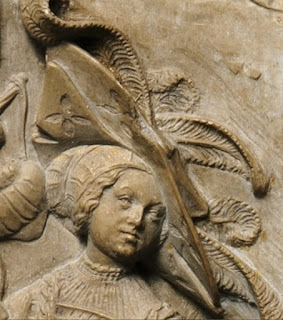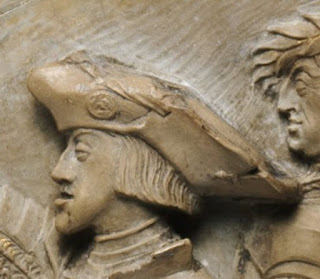Allegory of Virtues and Vices at the Court of Charles V by Hans Daucher 1522 (The Met Museum accession no. 17.190.745)
The Allegory of Virtues and Vices at the Court of Charles V features a lovely spectrum of hats from the early 16th century. Tallerbarret and Split Brim hats were discussed in the previous post so this post will look at floppy hats, upright brim and combination hats. I consider floppy, or "Star fish hats" to be distinct from split brim as cuts do not overlap and more slashed than cut and pieced. For this analysis "Split brim star fish hats" will be a combination of both where the splits clearly extend to the crown and overlap in places and are additionally slashed. There are a variety of floppy hat patterns to be found here (beware the poor livejounal formatting) and a good tutorial by Geoneva von Lubeck can be found here.
Further analysis is under the jump cut.
Star fish hats are one end member in the 15th century German Hat spectrum. So named due to the look of the brim which droops around the wearers head like they've plonked an unfortunate sea creature on their noggin. The shape of the hat, and the fact that the slashes extend up to half the length of the brim suggest a couple of construction methods. Annotations on Hat 7 suggest the brim is constructed from a double layer of fabric and partially slashed to create loops (blue). The loops provide additional bulk and stiffness helping maintain the shape of the brim.
Hats 8 & 9 show slashing depth and frequency is variable. While it's easy to assume the brim on these hats are slashed to align with the Landsknecht aesthetic, it is more likely that this is done to accommodate straight edge fabric. As discussed in the previous post, by piecing two sections together, a split brim hat uses less fabric than a full circle would. Slashing a straight or slightly curved piece of fabric will allow one side to settle into a larger arc than the other side. Slashes that reach from the brim to the crown will allow the fabric to sit horizontally around a circle even if the original fabric was straight significantly increasing the potential width of the brim.
Slashing a hat brim could be problematic if you desire a wide brim that doesn't flop in your face. Additional weight from feathers and decoration would cause non-reinforced slashes to further tear and the brim to droop. Hat 10 demonstrates one method for maintaining the structural integrity of the hat through the use of ties (yellow). A more detailed image of this feature can be seen in Hat 11, Durer's 1517 Portrait of a Man, where the brim is so well tensioned, the loops have become tight tubes at the top (red).
An alternate brim reinforcement method can be seen in Hat 12. A wide piece of fabric or ribbon appears to have been threaded through the sections of the hat, linking them together. A decorative and functional option that also adds visual appeal.
Split Brim Star Fish
A number of the remaining hats fall into the "Split Brim Star Fish" category with a slashed brim which has been formed from 2 or more pieces. It is possible to identify at least 4 discrete overlapping sections in Hat 13. Interestingly, the two looped, slashed sections are separated by smaller unslashed pieces. Hat 10, with its lovely bows, features a singular split without a tie. Unlike the slashes, this split goes from brim to crown and the two pieces overlap each other (red).
In Hat 14, the split brim construction is evident where the two sections overlap each other on opposite sides of the head (red). A single split clearly showing a loop of fabric indicates this is also a restrained version of a split brim star fish hat. Unique of all the hats in the sculpture, this hat also features decorative cutouts (yellow) on the brim section ends. Unlike the bows, there doesn't appear to be any justification for this apart from decoration.
Further analysis is under the jump cut.
 |
 |
| 7 - Floppy star fish hat? | |
Star fish hats are one end member in the 15th century German Hat spectrum. So named due to the look of the brim which droops around the wearers head like they've plonked an unfortunate sea creature on their noggin. The shape of the hat, and the fact that the slashes extend up to half the length of the brim suggest a couple of construction methods. Annotations on Hat 7 suggest the brim is constructed from a double layer of fabric and partially slashed to create loops (blue). The loops provide additional bulk and stiffness helping maintain the shape of the brim.
 |  |
| 8 - Multi-sectional split hats | 9 - a combination hat with multiple sections featuring slashe |
Hats 8 & 9 show slashing depth and frequency is variable. While it's easy to assume the brim on these hats are slashed to align with the Landsknecht aesthetic, it is more likely that this is done to accommodate straight edge fabric. As discussed in the previous post, by piecing two sections together, a split brim hat uses less fabric than a full circle would. Slashing a straight or slightly curved piece of fabric will allow one side to settle into a larger arc than the other side. Slashes that reach from the brim to the crown will allow the fabric to sit horizontally around a circle even if the original fabric was straight significantly increasing the potential width of the brim.
 |  |
 |  |
| 10 - Bows to prevent further splitting? | 11 - Additional support is provided by bows preventing the slashes from seperating further and joining the two sides of the loops together. Albrecht Durer 1516 |
12 - Threaded fabric or ribbon hat
An alternate brim reinforcement method can be seen in Hat 12. A wide piece of fabric or ribbon appears to have been threaded through the sections of the hat, linking them together. A decorative and functional option that also adds visual appeal.
 |  |
| 13 - Multi piece split brim starfish hat. | |
Split Brim Star Fish
A number of the remaining hats fall into the "Split Brim Star Fish" category with a slashed brim which has been formed from 2 or more pieces. It is possible to identify at least 4 discrete overlapping sections in Hat 13. Interestingly, the two looped, slashed sections are separated by smaller unslashed pieces. Hat 10, with its lovely bows, features a singular split without a tie. Unlike the slashes, this split goes from brim to crown and the two pieces overlap each other (red).
 |
 |
| 14 - Slashed split brim hat with decorative cutouts | |
 |
 |
 |
 |
| 15 - A sewn split brim hat with lashing along brim | 16 - A star fish hat with the brim raised by cord |
Upright brim hats
The Virtues feature two splendid hats which could, without too much wishful thinking, resemble a 'pirate hat'. The brims of these hats maintain an angle of ~120 degrees through two different methods. In Hat 15, the split brim appears to have been sewn together to raise the angle of the brim. Hat 16 employs bows or knots to maintain the slashed loops. One of these knots has been undone and instead the cord runs up and over the forehead of the hat forming a pseudo-tricorn (red). Both of these hats feature badge like disks which may also have been used to pin the brim to the crown,
 |
 |
 |
 |
| 17 - Floppy hat with slash | 18 - floppy hat with decorative slashes |
Floppy hats
There are three floppy hats in this sculpture. The two most clearly depicted (17 & 18) have a very similar brim, where the back half has been pushed up and the front curves down (blue). Hat 17 has a minor overlapping brim slash or division (red) while Hat 18 has a number of decorative slashes. Hat 19, is worn lashed together and tied to a it's owners back. The position of the feathers suggest we are looking at the base of the hat with the brim folded up and away from us. The crown of the hat appears to be a single piece with no cuts and overlaps evident.
 |
 |
| 19 - Floppy hat tied up for transport | 20 - Servants wearing straw hats |
These last hats are interesting because they share a deliberate texture created by the artist. While all of the wide split brim hats have been polished smooth, Hats 17-20 all feature a more woven or fur pattern. The servants (hat 20) wear hats with clearly defined sides and brims set at a ~30 degree downward angle. This suggests they are created from straw or some other stiff material. The previous three hats however all appear floppy and squishy. They are worn by a drowning officer (18), a foot soldier with halberd (17) and horseman (19) and all feature ostrich feathers which the headgear of the servants lack. I'd propose these are fur or a course wool thus explaining both the carved texture and the distinctly different brim style.
In the next part of this research, I'll examine the varied methods of crown construction and propose some thoughts on how to achieve a similar result.


No comments:
Post a Comment